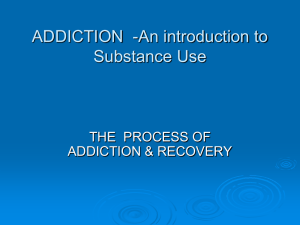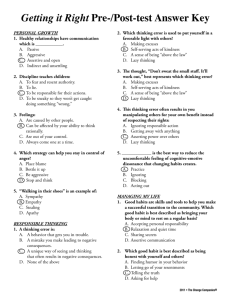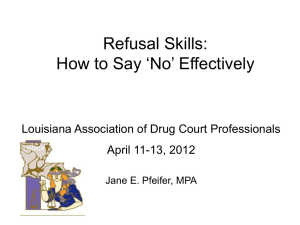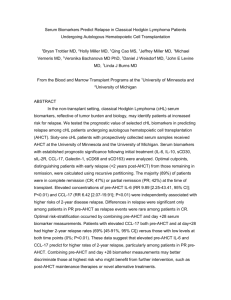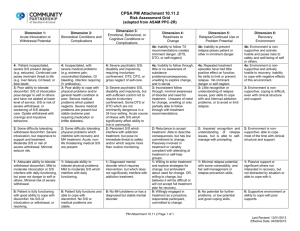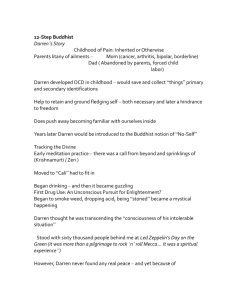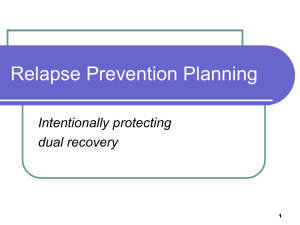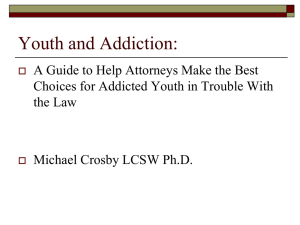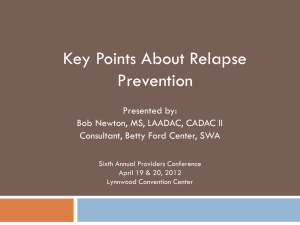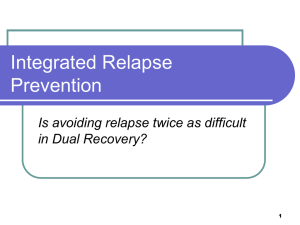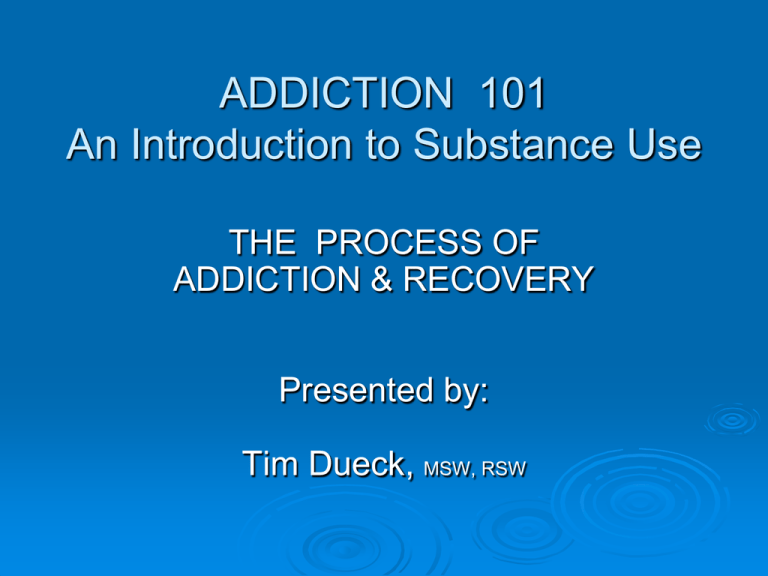
ADDICTION 101
An Introduction to Substance Use
THE PROCESS OF
ADDICTION & RECOVERY
Presented by:
Tim Dueck, MSW, RSW
What is a Drug?
A drug is any substance other than food which
changes the way the body or mind functions.
Drugs may or may not have medicinal properties
or purposes.
Drugs can come from plants or be made in labs.
Drugs can be legal, illegal, helpful or harmful.
Substance Use - Appropriate Use
To get better if you are ill (doctor’s
prescription).
To reduce pain from illness or injury.
To prevent illness (inoculation).
To manage mental illness by
balancing brain chemistry.
To help the body do things it can’t do on its
own (e.g. make insulin).
Psychoactive Drugs
Definition: Drugs that work on the mind or on behaviour.
Psychoactive drugs alter your mood and the way you think
and act.
Caffeine
Nicotine
Ritalin
Cocaine
Alcohol
Marijuana
LSD
Xanax
Valium
Heroin
Why Do People Use Drugs?
Forget problems
Get high
Lose or gain weight
Relax, energize
Go to sleep, stay awake
Boredom, depression
Gain confidence
Be cool, socialize, friends
Experience altered states
Why Do People Use Drugs?
cont’d
Symbol of rebellion
Sex
Sports
Religious ritual
Have fun, excitement
Reduce anxiety
Experiment
Avoid withdrawal if dependant
Reduce pain (i.e. physical, emotional, etc.)
Substance Abuse / Misuse
Misuse or Abuse - any use of a drug that causes
personal problems such as health, work, relationship,
legal, financial emotional.
Frequent forms of abuse:
Too much - taking too much at one time or
taking smaller doses more often.
Too long - taking the drug after it is no longer
needed; extending the prescription.
Improper Use - taking the drug for a different
illness / complaint. Taking another person’s
prescription.
Substance Abuse / Misuse
cont’d
Frequent forms of abuse:
Improper Combination - Combinations of drugs
can produce unwanted, dangerous effects even death (e.g. alcohol and tranquilizers).
You do not have to be an addict / alcoholic to
have a problem with substances.
DSM IV - Definition of Substance
Dependence
Criteria: A person demonstrates 3 or more of the following,
occurring at any time in a 12 month period:
1
2
3
Tolerance as defined by either,
a) a need for markedly increased amounts to achieve intoxication, or
b) a markedly diminished effect with continued use of the same
amount.
Withdrawal as manifested by either,
a) the characteristic withdrawal syndrome for the substance.
b) the same (or closely related) substances are taken to relieve or
avoid symptoms.
Amount / Duration: The substance is taken in larger amounts or over
a longer period than was intended.
DSM IV - Definition of Substance
cont’d
Dependence
4
Control: There is a persistent desire or unsuccessful efforts to cut
down or control substance use.
5
Time: A great deal of time is spent in activities necessary to obtain
the substance (e.g. visiting doctors); use the substance (chain
smoking); or recover from its effects.
6
Activities / Commitments: Important social, occupational and
recreational activities are given up due to substance use.
7
Negative Consequences: The substance use is continued despite
persistent or recurrent physical or psychological problems that are
likely to have been caused or exacerbated by the substance (e.g.
current cocaine use despite depression that is induced by the drug).
Addiction - a practical definition
The 3 “C’s”
Control - there are repeated attempts to cut back
or control use, with episodes or loss of control in
between.
Compulsion - a person experiences a sense that
they must use. Can be due to tolerance,
withdrawal or psychological need.
Consequences - substance use is continued
despite significant negative consequences.
Other Definition
Substance abuse is any drug use
that breaks healthy connections
with family, friends and society.
Risk Factors - Personal Factors
Lack of attachment to healthy adults/mainstream
culture
Genetic / Biological factors / Drug effects
Personal characteristics (e.g. high vulnerability
to anxiety / depression; impulsiveness; etc.)
Health / Mental Illness
Sex / Gender
Early drug use
Risk Factors - External Factors
Family of Origin
Abuse from the family and others
Culture
External Stressors e.g. poverty; job stress; single
parenting; unemployment; divorce
Exposure to Trauma e.g. natural disaster; civil
war; international conflict, rape, etc
Availability of Substances
Peer Group
Possible functions:
It can be useful to understand what processes maintain an
addiction after drug use is no longer enjoyable.
provides role / identity / friends
helps forget the past
a way of avoiding responsibilities
withdrawal from intimacy
stave off physical withdrawal
slow suicide or self-punishment
acting out self hate
Addiction to Other Experiences
Since many of the factors which promote and maintain
addiction are psychological, or social, people can develop
addictions to other human behaviours.
Sex
Gambling
Exercise
Pornography
Shopping
Internet
Television
Role-playing games
THE PROCESS
OF
DEPENDENCY
Non-Users
Refers to people who choose to abstain from substance use.
Some reasons include:
Personal choice for health, personal or
social, or family reasons.
Membership in particular religious or
cultural groups.
Negative experiences of long-term
substance abuse / addiction.
Deciding that using is unpleasant or
dangerous.
Experimental Use
Refers to the first few times a person tries
alcohol or other drugs.
Possible contributing factors:
1. Willingness to try the drug.
2. Friends or acquaintances that use.
3. A sense of safety about the drug and the setting.
Possible reasons for experimenting include:
* Boredom
* Need to Belong
* Curiosity
* Depression
* Peer Pressure
* Desire for stimulating or exciting alternatives
Experimental Use
cont’d
Key Concept:
In experimentation, people are exploring
their relationship with the substance.
•
If they don’t enjoy the effects, they go back
to non-use.
•
If they do, they may become social users.
Experimental Use
cont’d
Risks:
Using too much and / or taking too strong a dose
due to inexperience.
Beginners do not know how much their body can
handle.
They often are teenagers, bingeing with the
intention of getting drunk / high.
If they are using street drugs, they often don’t
know the source / the dealer / manufacturer.
Social Use
Refers to using a substance in social settings. It is one factor
in the event but is not the main purpose of the gathering.
Key Concepts:
Using does not take priority over other
life activities and experiences.
Examples of Social Use:
No aspect of a person’s life is affected
negatively.
To socialize.
To celebrate important occasions.
Instrumental Use
Using a substance as an instrument to fulfill a purpose,
often seeking pleasure or avoiding pain.
Pleasure Seeking:
Fun, feelings of power and control.
Experiencing altered states and perceptions.
Reduces inhibitions.
Avoiding Pain
Psychological: suppress negative feelings such
as anger, guilt, shame, grief, boredom, etc.
Physical: seek relief from physical discomfort.
Habitual use
Drinking / drugging on a regular basis, potentially increasing
risk for problems in one or more areas of a person’s life.
Key Concepts:
Problem use is generally characterized by frequent use of substance.
Problems may emerge in areas of:
* Relationships
* Work / School
* Health
* Finances
* Legal Status
Social life and circumstances may narrow to include only other users and
social functions involving using.
A person is not considered dependant at this point and still has some
choice about their usage.
Compulsive Use
The person experiences an overwhelming physical and / or
psychological need to use.
Key Concepts: A person experiences:
Physical Dependence, including:
a) Tolerance - a need for increasing doses
to feel the same high.
b) Withdrawal - characteristic of the
particular drug; usually the opposite effect
of the high.
Compulsive Use
cont’d
Psychological Dependence
a) - an all-consuming focus on the drug
(getting it, getting high, dealing with
coming down, finding more); brain
chemistry has changed.
b) - person experiences no choice about
using and feels no control over the amount
consumed.
Binge Use
Refers to heavy drinking or drugging on a sporadic basis, with
periods of little or no use in between.
Key Concepts:
Binge use can be as problematic as regular use.
Binge drinking is often associated with higher levels of:
* hostility and aggression
* police altercations
* domestic violence
* work problems
* hospital admissions (in comparison to heavy, steady users)
The unpredictable nature of binge use can create a
destructive set of stressors for those involved in the
user’s life.
THE PROCESS
OF
RECOVERY
Recovery is a process that involves:
Stages of Recovery
Early Recovery: Getting Clean
• Concrete changes in daily living
• Adequate sleep, diet, exercise
• Staying away from those who are using
• Building support; education
Stages of Recovery
Middle Recovery: Stabilization
• Able to turn energies to family, work, relationships,
friendships
• Support, life skills, relaxation, stress management
• Less focus on using
Stages of Recovery
Late Recovery: Maintenance
• Insight into early trauma
• Healing, repairing self-esteem
Aspects of Recovery:
•
•
•
•
•
•
•
Recognition
Cessation
Education
Support
Counselling
Relapse Prevention
Dealing with Underlying Issues
Model of Change
Model of Change
Relapse
Definition:
• Relapse: Return to previous behaviors
Relapse Factors
Common Triggers of Relapse
Individual
•
•
•
•
•
Unpleasant feelings
Unpleasant physical states
Positive emotional states
Testing personal control
Urges, cravings
Relapse Factors
Common Triggers of Relapse (cont.)
Interpersonal
• Enhancing good feelings
• Social Pressure
• Conflict with others
Personal Relapse Factors
• People – former ‘using’ friends (i.e.
dealers, partiers, etc.)
• Places – former ‘using’ settings (i.e. pubs,
crack-houses, etc.)
• Things – former ‘using’ objects /
paraphernalia (i.e. pipes, etc.)
Personal Relapse Factors
• Times – former ‘using’ rituals (i.e. beer after
work, etc.)
• Activities – previously associated with
substance use (i.e. pool, darts, etc.)
• Emotional states – emotions previously
associated with substance use (i.e. anger,
etc.)
• Events – events formerly associated with
substance use (i.e. concerts, etc.)
Blaming
• Addiction is often maintained by the process
of blaming (people, events, myself, etc)
• Blaming occurs through the process of
projection
• Healing from this requires both insight and
the willingness to take responsibility for
one’s life
• Blaming is looking backwards, responsibility
is about looking forwards
Processing a Relapse
A relapse is not inevitable but it is a common experience in
the recovery process. It can be an opportunity to learn:
•
•
•
•
What was the trigger(s)?
What was the high risk situations?
What will one do differently in the future?
How did the person manage to stop drinking /
drugging?
• How was this lapse / relapse different from the last
one? In what ways is the person stronger / wiser?
What does the person know now that they
did not know before?
ADDRESSING
SUBSTANCE-USE
WITH OTHERS
Relevance
• Motivational information
has the greatest impact.
• Always tailor discussion to
each person.
• Disease status or risk
• Family or social situation
• Age, gender
• Prior experience in
recovery
Risks
• Highlight the risks of continued substance use and
also the risks of change.
• Ask the person to outline
potential consequences
and benefits on both sides
of issue.
• Emphasize that loss may
occur whenever life changes
are made.
Rewards
• Ask the patient to identify the benefits of using as well
as potential benefits of ending substance use.
• Improved health
• Feel better physically
• Not worry about
hurting loved ones
• Modeling healthy lifestyle
choices to children
Roadblocks
• Assist person to identify barriers to making
change.
• Lack of belief in ability to change
• Withdrawal symptoms
• Fear of failure
Repetition
•
Reinforce the motivational messages at every visit.
•
Re-enforce to those not yet ready to make changes that
when they are ready to discuss substance use, you are
there to help.
You become successful the
moment you start moving
toward a worthwhile goal.
(Unknown)

